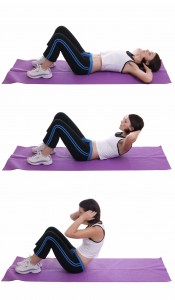 How to Improve Core Support for a Healthy Back, Better Abs, and the Best Pilates Exercise Technique Possible
How to Improve Core Support for a Healthy Back, Better Abs, and the Best Pilates Exercise Technique Possible
Do you struggle with really finding and working the lowest little pieces of your mid-section for core support? Is “belly button to backbone” your go-to cue when you think about ab work and core support? Do your neck muscles fatigue faster than your abdominals when you do sit-ups, or other core strengthening exercises like the Hundred in a Pilates mat class?
Well if any of these resonate with you, then please keep reading because I’ve got 3 Pilates Training Tips (and probably a few extra secrets to share) that can help you improve core support, keep your lower back healthy, get more good work from your middle, and dramatically help you improve your Pilates exercise technique.
Pilates Training Tip #1 for Core Support – Neutral Spine vs. Pilates Scoop
First – let’s chat about Neutral Spine vs. a Pilates Scoop! Personally, you have to be stronger than an OX to maintain a “neutral spine” and keep core support on exercises like the Hundred. And the reality of the situation is, you’ve probably got more work aka-strain (and potential risk for injury) happening in your low back, quads, and hip flexors, than effective use of your middle. If you’re lower back is striving to maintain an “arched” position, but you’re attempting to curl the head and shoulders up off the mat, you are in effect playing tug of war on the spine, which is not healthy for your back, and not in any way, shape, or form going to get your low abs working for better core support. I am not poo-pooing neutral spine for all exercises. It’s a very important position to understand and have the muscle strength to control. Pilates is all about length and strength – regardless of “neutral” or “scoop” we should always be striving for a lengthened position. I just think you’re going to be a lot safer on spine flexion exercises if you actually allow the spine to bend!
So as you might have guessed by now, I’m a fan of the Classical Pilates Scoop. But even this can be done incorrectly. You need to activate your Pelvic Floor, along with Low Transverse Abs, and High Hamstrings to lengthen the low back and scoop the waist to the mat. Hamstrings and Glutes work to hold the scoop from underneath the pelvis, and also work hold up the thighs when the legs are extended. Allowing the lower back muscles to relax and lengthen first, cues the muscles in the front of the body to activate more – and Voila! You’re holding with better muscle support in the basement of your belly.
If you need to curl up farther for exercises like the Pilates Roll Up or Teaser, the back muscles continue to relax while the front of you works harder. If you need to hold and maintain a curled-up position like during the Series of 5, the back muscles will hold along with the front for stabilized core support. I realize that maintaining length and working on strength is the challenge of core support, that’s why Pilates is a “practice.” Always strive to make your last repetition the best one ever!
Pilates Training Tip #2 for Core Support – Stop pulling your “Belly Button to the Back Bone”
Ok it’s time to dispel the myth that “Belly Button to the Backbone” is a good cue to use for core support! I know, I learned it too…but seriously, it’s NOT HELPING, and very likely is contributing to poor execution and certainly not going to provide you with the right support during exercises when you really need to shore things up and keep your pelvis and low back in a safe position.
When you pull one specific spot, “belly button” to the back bone. Or the other cue for this might be “navel to spine” you have one contact point of support and that’s it! What about all the rest of the muscle tissue in your middle?
The only bones that run between your hips and ribcage are your back bones, and they are vertical. How is pulling your navel to spine possibly going to support the lift and length needed for good core support to keep the distance between your hip bones and ribcage? Stop pondering this, because it’s impossible! Your Rectus Ab muscles are your “crunch” muscles. While a 6-pack might look stellar, these are not the important muscles you need to train for core support. It’s your Oblique’s that help define the distance (for length) between the ribcage and the hips. And it’s your Transverse Abs that are your God-given girdle to pull the contents of your mid-section up, in and back for true support. Your back muscles participate here too to lift and lengthen the spine. And the Legs are involved too, only NOT the hip flexors in the front, it’s the high Hamstrings along the back of the thigh that keep you out of your grippy hip flexors so your Abs can effectively lift up and away from the legs.
Watch someone who’s a strong belly-button-to backbone ab contractor, and you’ll notice that the body looks like it’s been chopped in half when they pull their belly in. That one point in the middle dips down, and the low abs from the crotch to the navel pooch out. What does this mean for your pelvis… Zero core support to stabilize the pelvis and lumbar spine, a crappy curled up position that’s more in your neck and shoulders than low abs, and not a chance at good hip mechanics for gait to walk and run with a healthy stride.
What do you need instead? Exercises to help you find and strengthen the basement of your belly, the Low Center, your “low smiling” transverse abdominal muscles that are designed to pull the contents of your guts up, in, and back to hold your belly inside the cavity of your body. If your guts are spilling out over your belt, your pelvis and back are out of alignment, and as hard as you try, your back muscles will remain in an over-holding pattern until your pelvic floor and low transverse muscles get strong enough to help improve the placement of your pelvis and posture. Are you ready for the best gift ever… Every Pilates exercise, every moment of the day, and every other sport, and physical activity you participate in, gives you the opportunity to practice using and finding these ever-so-important core support muscles! The question becomes, are you paying attention, and striving to find and use the right muscles regularly?
This is ever so important to remember: If you’re Abs are popping out to the front, they’re not working properly! In curled-up Pilates exercises your eyeballs should be focusing on your low belly. Watch it and see what’s happening. Do you see it hollow out, and flatten down, or pop out? It’s always easier to eek a little more good muscle work out of your Abs on an exhale, but ideally, the Transverse Abs start pulling up, in, and back with you as you inhale! Just by practicing good Pilates posterior-lateral breathing, you can start improving your core support.
Pilates Training Tip #3 for Core Support – What’s Your Current Core Support Habit
What’s your go-to place for Core Support? Do you know?
Lay on your back with your knees bent and feet flat on the floor. Place your hands behind your head to support the neck. Now curl up, and tell me what happened?
Did you:
a. Tuck your hips, by squeezing your Glutes and “crunch” your hips and ribs closer together as you curled the head and shoulders up off the mat. (Your Abs will pop up and bulge out when this happens.)
b. Yank on your head with your hands, and pull yourself up with your nice strong arms and shoulders. (Poor head and neck is now strained, and out of alignment…)
c. Activate your pelvic floor to stabilize the tailbone in a lengthened position, and while releasing the low back muscles, activate the “low smile” (Oblique’s) to pull from the front of your crotch (without tucking, or moving the pelvis) the lowest part of your abdominal muscles up in and back towards the bottom back ribs on the mat, so that you can maintain the low back on the mat, lengthen the ribs away from the hips, and drop the bottom of your breastbone down, to float the head and shoulders up off the mat.
This is the difference between Pilates done well, and going through the motions of a “Pilates” exercise. A well-trained Pilates teacher will be able to help guide you into a good position, and help educate you about your current habits vs. new habits you can work to develop for better whole-body health. There are a lot of great Pilates teachers out there! One on one training can be a priceless investment in your health to fine-tune your fitness habits for better core support.
Ok, so the exercise above hopefully helped bring to your conscious level of awareness, your current core strengthening habits. Chances are whatever you did on this simple curl-up prep exercise, is your go-to habit for all of your core training exercises. My hope is that version c is your healthy movement habit, since it’s the one that best serves the body for better core support. There is a huge difference in core support when you’re working and strengthening your “Low Center” vs. “High Center.” I’ll save this as a training topic for another day.
How Can You Get More from Your Core?
- Practice Pilates Posterio-Lateral Breathing Techniques
- Strengthen your Pelvic Floor properly (a Kegel exercise won’t do it!)
- Get your Oblique’s working well (Stop pulling your Belly Button to your Backbone)
- Find a great Pilates Teacher and invest in Private Training to fine-tune your exercise technique (remember – length and strength for good core support)
- Learn the difference between working in High Center vs. Low Center
There are no bad exercises, only exercises done badly. I’m not sure who said this, but it’s true. And most certainly, not every exercise is for every body! But good core support is something that everybody needs for a lifetime of good health. Take the time to shore up your core, and learn how to effectively find and use the right muscles for proper core support during Pilates and throughout the day with everything you do. Core support matters for good posture, safe exercise technique, and a healthy, active, pain-free life. Get centered with good core support.
***
Learn how to Effectively Engage the Pelvic Floor to Help Strengthen the Core with this eCourse from Aliesa George and Centerworks.


0 Comments